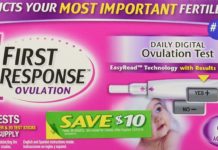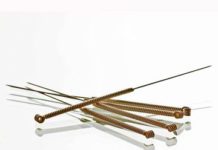
As any trying to conceive (TTC) couple knows, a woman is most likely to get pregnant during her “fertile window,” which includes the day of ovulation and the five days leading up to it. Here’s your ultimate guide to finding your fertile window and increasing your odds of successful conception.
What is a Fertile Window?
During ovulation, an egg released from a woman’s ovary travels down her fallopian tube. It survives in the reproductive tract for 12-24 hours. Conception can occur if sperm fertilizes the egg during this time; otherwise, the egg sheds with the uterine lining during menstruation.
Your chances of getting pregnant are highest within 24 hours of ovulation and one day beforehand. But conception is also possible if you have sex in the five days leading up to ovulation, says Rashmi Kudesia, M.D., an Ob-Gyn and reproductive endocrinology and infertility specialist at Houston Methodist and Houston IVF. That’s because sperm can survive in the reproductive tract for five days, meaning that days-old sperm can still fertilize a newly released egg.
How to Calculate Your Fertile Window
If you’re looking to calculate your fertile window, online ovulation calculators (like this one from Parents) can give speedy results. But since few women have consistently regular cycles, they aren’t always accurate. Here are some of the most effective ways to calculate your fertile window.
Tracking Your Cycle
“When trying to predict the fertile window and ovulation, it’s important to determine cycle length by creating a menstrual diary,” says Sharifa Menon, M.D., F.A.C.O.G, an Ob-Gyn at Westchester Medical Center, the flagship of the Westchester Medical Center Health Network (WMCHealth). Start by tracking your menstruation for a few months using a paper journal or mobile app (check out our top picks here). Then look at the data to determine your average cycle length.
The first day of the menstrual period is considered day one of the cycle, and ovulation usually happens about 14 days before your next period is due. “For example, if the interval between periods is 28 days, we would predict ovulation occurs on day 14. Alternatively, if the cycle length is 30 days, we would expect ovulation on day 16 of the cycle,” says Dr. Menon. Since a woman is most likely to conceive on the day of ovulation and the five days before it, the fertile window for these examples is days 9-14 and days 11-16, respectively.
Ovulation Predictor Kits (OPKs)
Available at most drug stores, ovulation predictor kits (OPKs) use a urine test to identify the fertile window. They work by monitoring the luteinizing hormone (LH), which surges roughly 36 hours before ovulation. TTC couples should plan to have intercourse shortly after detecting the surge.
Monitoring Cervical Mucus
“During the fertile window, cervical mucus increases in volume, and it tends to be more clear and slippery compared to other times of the cycle,” says Dr. Menon. If you notice your mucus looking slimy and thick (almost like egg whites) there’s a good chance you’re ovulating.
Charting Basal Body Temperature (BBT)
A woman’s resting body temperature rises during ovulation by at least two-tenths of a degree. Taking your basal body temperature first thing in the morning with a BBT thermometer can help monitor ovulation. "As this method only detects ovulation after it has already occurred, I would only recommend this to help confirm ovulation or gain a sense of one’s average ovulation day,” says Dr. Kudesia.
Fertility Monitors
These ovulation calculators monitor your LH and estrogen to determine your most fertile days. They’re effective but pricier than ovulation predictor kits.
Visiting a Doctor
For those with fertility issues, doctors can sample blood to see progesterone levels, which can confirm ovulation. "Doctors also can use a pelvic ultrasound to monitor ovulation," says Jingwen Hou, M.D., Ph.D., an Ob-Gyn specializing in reproductive endocrinology and infertility at Kaiser Permanente in Hawaii.
When Will I Conceive?
Of course, the best way to conceive is through regular intercourse. Aim to have sex every 1-2 days during the fertile window. Keep in mind, however, that conception probably won’t happen right away. “Even if the timing is perfect and there are no other diagnoses at play, the chance of pregnancy per month is about 25 percent for young women (under the age of 30) and drops to less than 5 percent by the time we get to our 40s,” says Dr. Kudesia.
She also warns that if your typical menstrual cycle isn't between 21-35 days, you might not ovulate regularly. Couples may be suffering from infertility if they’ve haven’t conceived after one year of trying (or 6 months of trying if they’re over 35). In this case, consider visiting a reproductive endocrinology and infertility specialist. “There are many factors that could be at play – some relate to lifestyle and may be modifiable, but in other cases, medication is required to induce ovulation,” she says.
































